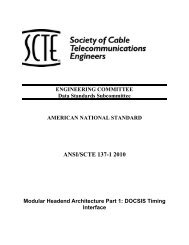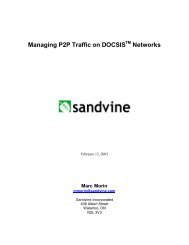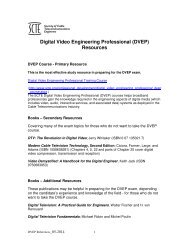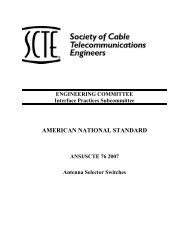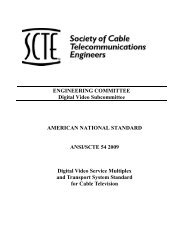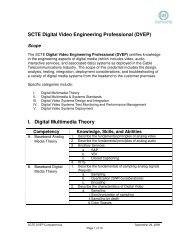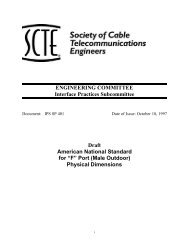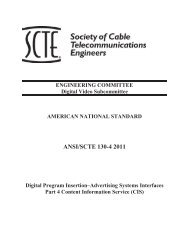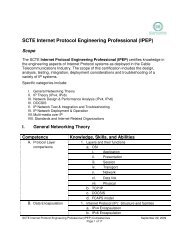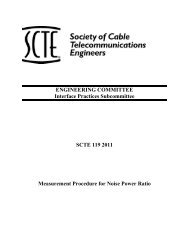Working at a Small-to-Medium Business or ISP CCNA ... - SCTE
Working at a Small-to-Medium Business or ISP CCNA ... - SCTE
Working at a Small-to-Medium Business or ISP CCNA ... - SCTE
You also want an ePaper? Increase the reach of your titles
YUMPU automatically turns print PDFs into web optimized ePapers that Google loves.
xxxv■■■SSHDHCPStreaming videoHow This Book Is OrganizedThis book covers the maj<strong>or</strong> <strong>to</strong>pics in the same sequence as the online curriculum f<strong>or</strong> the <strong>CCNA</strong>Discovery <strong>W<strong>or</strong>king</strong> <strong>at</strong> a <strong>Small</strong>-<strong>to</strong>-<strong>Medium</strong> <strong>Business</strong> <strong>or</strong> <strong>ISP</strong> course. The online curriculum has ninechapters f<strong>or</strong> this course, so this book has 10 chapters with the same names and numbers as the onlinecourse chapters.To make it easier <strong>to</strong> use this book as a companion <strong>to</strong> the course, the maj<strong>or</strong> <strong>to</strong>pic headings in eachchapter m<strong>at</strong>ch (with just a few exceptions) the maj<strong>or</strong> sections of the online course chapters. However,the Learning Guide presents many <strong>to</strong>pics in a slightly different <strong>or</strong>der under each maj<strong>or</strong> heading.Additionally, the book occasionally uses different examples than the course. As a result, you get m<strong>or</strong>edetailed explan<strong>at</strong>ions, a second set of examples, and different sequences of individual <strong>to</strong>pics, all <strong>to</strong> aidthe learning process. This new design, based on research in<strong>to</strong> the needs of the Netw<strong>or</strong>king Academies,helps typical students lock in their understanding of all the course <strong>to</strong>pics.Chapters and TopicsPart I of this book has 10 chapters:■■■■■Chapter 1, “The Internet and Its Uses,” discusses the Internet—how it is evolving and howbusinesses and individuals make use of it. The imp<strong>or</strong>tance of the <strong>ISP</strong> and standards in the continuinggrowth of the Internet is emphasized. This chapter focuses on the Internet infrastructure,including POPs, IXPs, and the types of devices <strong>ISP</strong>s use <strong>to</strong> provide services.Chapter 2, “Help Desk,” introduces the help desk and the various roles of help desk andinstall<strong>at</strong>ion technicians. It also describes the levels of supp<strong>or</strong>t provided by these personnel. Thischapter reviews the seven layers of the OSI model as they rel<strong>at</strong>e <strong>to</strong> help desk supp<strong>or</strong>t and theiruse in troubleshooting netw<strong>or</strong>k issues. Common <strong>to</strong>ols and diagnostic procedures used by helpdesk technicians are examined, as well as on-site procedures used <strong>to</strong> resolve issues.Chapter 3, “Planning a Netw<strong>or</strong>k Upgrade,” emphasizes the imp<strong>or</strong>tance of proper planningwhen perf<strong>or</strong>ming a netw<strong>or</strong>k upgrade, including the use of a site survey, and it describes thesteps involved in perf<strong>or</strong>ming one. An overview of structured cabling is provided, along with thefac<strong>to</strong>rs you must consider when upgrading LAN and internetw<strong>or</strong>king devices.Chapter 4, “Planning the Addressing Structure,” describes how IP addressing is implementedin the LAN and compares classful and classless netw<strong>or</strong>ks and subnets. This chapter explainsthe process f<strong>or</strong> subnetting a netw<strong>or</strong>k <strong>to</strong> allow f<strong>or</strong> efficient use of available IP addresses. In addition,it describes how Netw<strong>or</strong>k Address Transl<strong>at</strong>ion (NAT) and P<strong>or</strong>t Address Transl<strong>at</strong>ion (PAT)are used in modern-day netw<strong>or</strong>ks.Chapter 5, “Configuring Netw<strong>or</strong>k Devices,” introduces the ISR and the methods available f<strong>or</strong>configuring an ISR using both in-band and out-of-band techniques. This chapter introduces SDMand IOS commands and discusses how each is used <strong>to</strong> configure a Cisco device. The purposeand rel<strong>at</strong>ionship of the device startup configur<strong>at</strong>ion and the running configur<strong>at</strong>ion are explained.In addition, Cisco Discovery Pro<strong>to</strong>col (CDP) is introduced. Finally, the types of WAN connectionsavailable are discussed and compared in terms of cost and speed.



